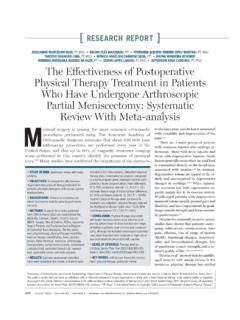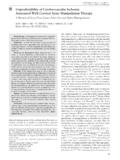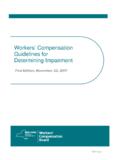Transcription of Conservative Interventions for Carpal Tunnel …
1 Conservative Interventions for CarpalTunnel SyndromeSusan L. Michlovitz, PT, PhD, CHT1 The assessment and Conservative Interventions in patients with Carpal Tunnel syndrome (CTS) aredescribed in this paper. Information about surgical procedures and postoperative care has alsobeen included. It is difficult to make definitive conclusions about the literature regarding successof treatment for CTS due to variations in outcome measures, severity of CTS, and inconsistenciesin duration, dosage, and follow-up time for Interventions . Based on what is known to date, thisauthor recommends that patients with mild or moderate CTS be provided with a conservativeprogram of splinting the wrist in neutral for nocturnal wear. In addition, intermittent exercise(nerve-gliding exercises) and activity modification, including avoidance of protracted periods ofsustained gripping activities and awkward wrist positions, can be useful.
2 This conservativeprogram may be complemented by pain-relieving modalities during times of activity andsupplemental participation in other exercise such as yoga. If symptoms are not relieved to thesatisfaction of the patient, or they recur, then it is incumbent upon the therapist to refer the patientto a hand surgeon for injection or possible surgical Orthop Sports Phys Ther2004;34 Tunnel syndrome (CTS) results from compression ofthe median nerve within the Carpal Tunnel in the wrist. CTSis a common upper extremity entrapment neuropathy19andis estimated in one study to occur in 1% to 3% of thegeneral strategies presently in-clude attempts at prevention or recurrence of the disorder, conservativenonsurgical Interventions , and surgical ,43 This paper will address (1) the signs and symptoms of CTS, (2) theselection of patients for Conservative nonsurgical care, (3) outcomemeasures to determine treatment effectiveness and patient change, (4)the rationale for Conservative nonsurgical intervention, and (5) manage-ment and expected recovery following Carpal Tunnel release (CTR).
3 Acompanion paper by MacDermid discusses the tests and measures usedto diagnose CTS. This commentary will not discuss diagnosis, but,rather, the outcome measures used to determine intervention effective-ness after the medical diagnosis of CTS has been AND SYMPTOMS OF CTSThe signs and symptoms associated with compression of the mediannerve within the Carpal Tunnel usually include paresthesia, tingling,numbness, and/or pain within the cutaneous distribution of the mediannerve to the thumb, index, middle, and radial half of the ring paresthesia is a frequent complaint; this tingling in the hand1 Professor, Physical Therapy, Temple University, Philadelphia, author of this paper is a consultant to Procter & Gamble on heat therapy (Thermacare Heat Wraps)and was involved in the design and implementation of the reported study on heat wraps for wrist correspondence to Susan L. Michlovitz, Temple University, 3307 N Broad Street, Philadelphia,PA 19140.
4 E-mail: interrupts sleep may be par-tially relieved by shaking the handback and forth. Pain may radiateinto the palm and up the forearmand arm. These primary com-plaints of paresthesia and paintypically cause the patient to seekmedical ,49 With compression of the mediannerve in the Carpal Tunnel , theskin overlying the thenar emi-nence is usually spared becausethis area is innervated by the me-dian nerve s palmar cutaneousbranch. The branch originatesfrom the median nerve before itenters the Carpal Tunnel and liesvolar to the Tunnel . Paresthesia inthe distribution of the palmar cu-taneous branch of the mediannerve (skin overlying thenar emi-nence) should suggest a lesion ofthe median nerve proximal to thecarpal Tunnel . This requires fur-ther examination for a moreproximal lesion, such as a brachialplexopathy or cervical SELECTION FORPHYSICAL THERAPYINTERVENTIONWhen planning examination,prognosis, and intervention for pa-tients with CTS, knowledge of theseverity of CTS is important.
5 Forexample, a person with mild CTSmay have symptoms successfully re-solved with night use of splintsand activity modification, whilesomeone with moderate or severeCTS may be less likely to haveJournal of Orthopaedic & Sports Physical Therapy589 CLINICAL COMMENTARYTABLE conditions associated with Carpal Tunnel syn-drome. (More comprehensive lists can be found in the refer-ences cited in the text of this article.)Local to upper quadrant Basal (thumb carpometacarpal) joint arthritis Distal radius fracture Dupuytren s contracture Proximal compression on median nerve Scaphotrapeziotrapezoid (STT) arthritis Trigger finger/thumbSystemic condition Diabetes mellitus End-stage renal disease on renal dialysis Long-term haemodialysis Pregnancy Rheumatoid arthritis Thyroid disease (hypothyroidism)splint usage be effective or efficacious. CategorizingCTS as mild, moderate, or severe10can provide astructural framework for intervention choices (seeMacDermid s paper in this issue).
6 While many cases of CTS are idiopathic in nature,a recent report suggests that there may be a geneticpredisposition for developing the account for individual differences in the symp-tom threshold (ie, some individuals who do the sameamount of repetitive activity that cause symptoms inothers do not have symptoms themselves).There are certain other hand disorders (Table 1)which occur concomitantly and/or are associatedwith ,9,34,39,56,62,69,79,80,97In this author s experi-ence, patients have been referred to physical therapywith a diagnosis of CTS when other conditionscoexist and these conditions must be taken intoaccount if intervention strategies16,94are to be suc-cessful. In some instances, the diagnosis of CTS ismade by inexperienced yet well-intentioned cliniciansand other disorders must be recognized and MEASUREST ests and measures used for determining a medicaldiagnosis may not always be useful to judge patientchange as a result of intervention.
7 For example, themedian nerve compression test is used in the diagno-sis of the pathology of CTS but can not be quantifiedin a way that would help determine if a patient wasgetting better, worse, or not changing as a result ofan intervention. Therefore, we must select measuresthat are responsive to change and that reflect thechanges in impairments, functional limitations, anddisability that may be attributed to therapy interven-tion. Outcome measures of Interventions can includethe Boston Carpal Tunnel Scales questionnaires,49grip and pinch strength, manual muscle testing(particularly of the thenar muscles), light touch withmonofilaments, and various timed tests of handfunction requiring manipulation of objects. Thesemeasures are employed during examination at theinitiation of therapy and during follow-up has been an emphasis over the last decadeon the importance of patient self-administered ques-tionnaires for report of pain and disability.
8 It isparticularly important to include a self-report meas-ure with good psychometric properties to best cap-ture the essence of the patient s complaints anddifficulties. For example, with CTS, severe symptomsof paresthesia may not be associated with deficits ingrip or complaints of weakness,66impairments tradi-tionally measured during a physical therapist s exami-nation. In addition, there is not a good correlationbetween results of electrophysiological studies andsymptoms the patient the CTSprogresses, the symptoms of paresthesia may decreaseand be replaced with actual muscle atrophy andweakness. If the disorder has progressed to the pointof thenar muscle atrophy, then nonsurgical treatmentmay not be appropriate or Boston Carpal Tunnel Scales questionnaires49are commonly used to assess individuals with CTSand include the Symptoms Severity Scale (SSS) andthe Functional Status Scale (FSS).
9 These scales takeabout 5 minutes for a patient to SSSquestionnaire is composed of 11 questions related tothe severity of nocturnal pain and paresthesia, fre-quency of wakening at night, pain in the hand andwrist during the day, presence of numbness orweakness in the hand, and difficulty manipulatingsmall objects. Each question is rated from 1 to 5, with5 being the most severe. The scores for each questionare then added and divided by 11. The reportedscore is a number out of a total of The FSS asksabout 8 activities, including writing, buttoning, hold-ing a phone, carrying groceries, holding a book toread, opening jars, household chores, and bathingand dressing. This is scored in a similar fashion tothe SSS questionnaire. This author uses informationobtained from administration of these scales to assistin formulating functional intervention SSS and FSS questionnaires capture aspects ofsensation, pain, and function, and have been vali-dated for use in individuals with CTS and followingCTR.
10 Amadio et al2have reported outcomes follow-ing CTR using these scales. Katz et al41reported thatthe SSS and FSS were 2 and 4 times more responsive,respectively, to clinical improvement than measures ofneuromuscular impairment, such as grip strength,manual muscle test, 2-point discrimination, and lighttouch with monofilaments. Atroshi et al4reportedsimilar findings. These authors recommend that theseself-report measures should serve as primary out-comes in clinical studies of therapy for CTS. The SSSand FSS questionnaires are more sensitive to clinical590J Orthop Sports Phys Ther Volume 34 Number 10 October 2004change produced by surgical treatment for CTS thanother health status questionnaires such as the Arthri-tis Impact Measurement Scale and the addition, in the postoperative cases, there didnot seem to be a relationship between wrist range ofmotion, pinch and grip strengths, monofilamentpressure sensibility, and patient ,41 Thesescales are valid as self-report measures for bothrecipients and nonrecipients of worker s ,41 Maximum grip strength is frequently measured inpatients with CTS.


